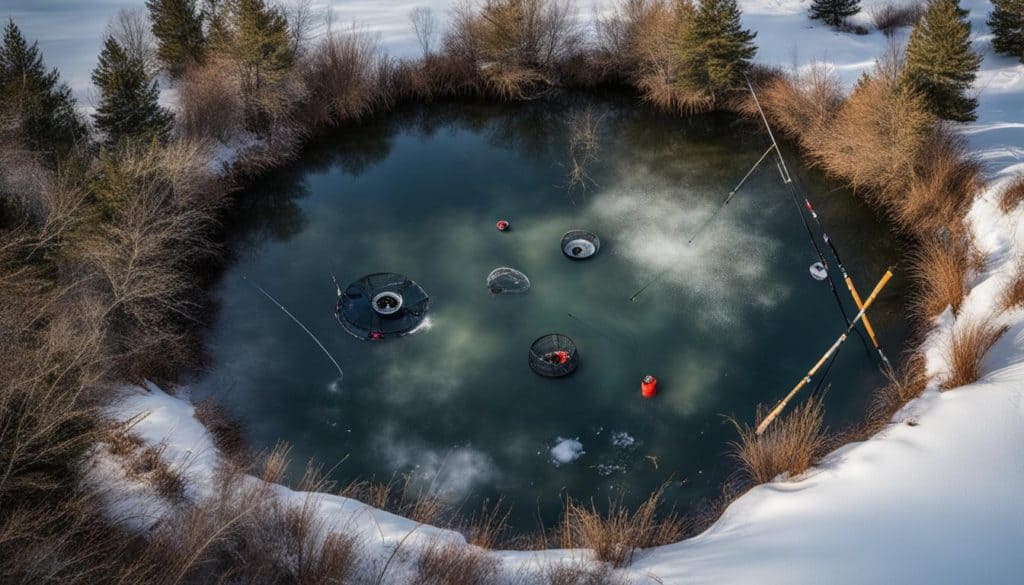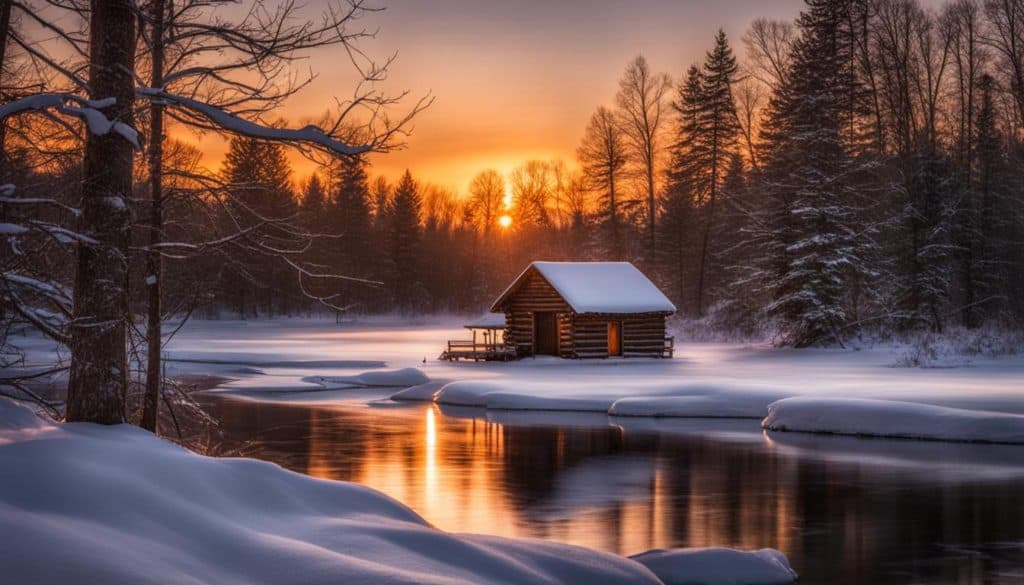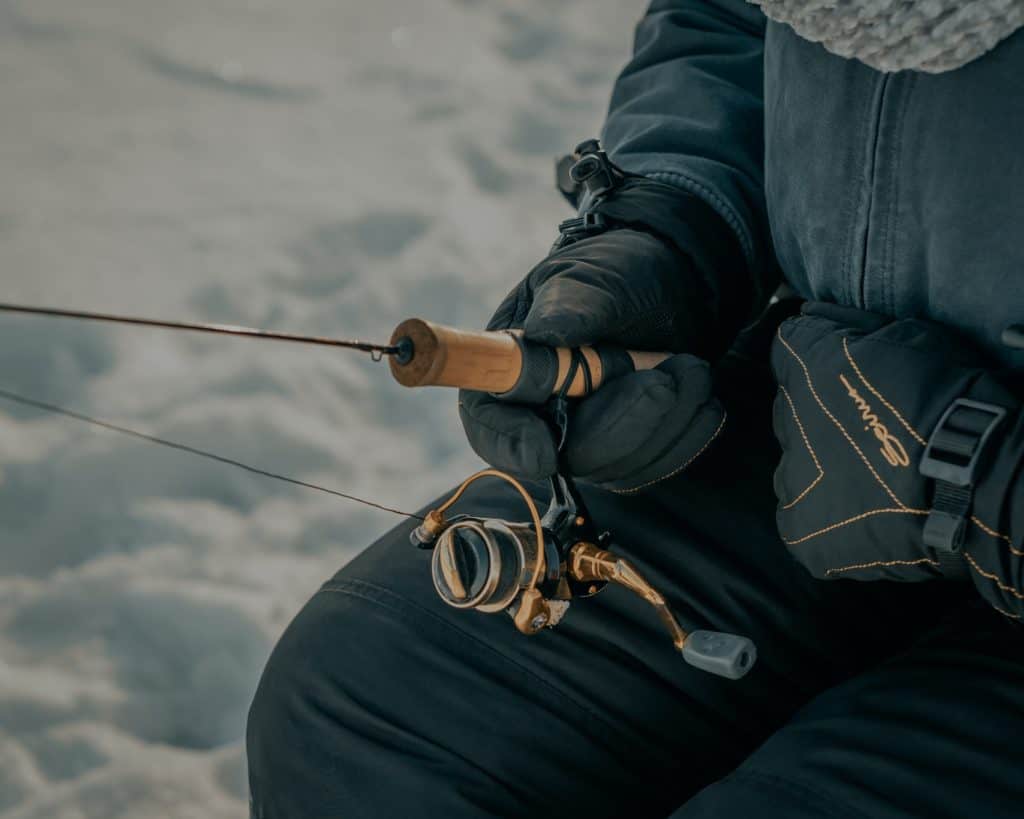Ice fishing for bass in ponds is an exciting and rewarding activity. Contrary to popular belief, bass can be caught under the ice. The fish congregate on the bottom and are often sluggish and slow, but they still need to feed. By adjusting your tactics and using the right techniques, you can increase your chances of catching bass during ice fishing.
Key Takeaways:
- Ice fishing for bass in ponds can be an exciting and rewarding experience.
- Bass congregate on the bottom and are sluggish during winter, but they still need to feed.
- Adjust your tactics and techniques for ice fishing to increase your chances of catching bass.
- Use smaller gear and bait choices for ice fishing for bass in ponds.
- Stay safe and follow proper safety precautions when ice fishing.
Adjusting Tactics for Ice Bass Fishing
When it comes to ice fishing for bass in ponds, it’s essential to adjust your tactics for the winter conditions. Since bass congregate on the bottom and are more lethargic, you need to employ specific techniques to increase your chances of success.
The first tip is to fish weed lines and depth transitions in the pond. Bass tend to school in these areas for warmth, and if you catch bass in one spot, they are likely to be there again. Additionally, place your baitfish right off the bottom to entice the sluggish bass to feed. I often target depths of 7-16′ feet for ice bass, as they tend to like that depth in most of the Midwestern ponds I have fished.
To mimic the movements of an easy meal, jig slowly with tungsten jigs or ice spoons. This technique can entice the bass to strike while conserving their energy. Don’t be afraid to move your tip-ups to productive areas and drill new holes to find the best spots. Late in winter, keep an eye out for drop-offs in the pond, as bass will still transition depths frequently.
By following these tips and adjusting your tactics for winter bass fishing, you can increase your chances of catching bass during ice fishing. Remember to adapt your approach based on the conditions and be patient. With perseverance and the right techniques, you’ll have an enjoyable and successful ice fishing experience.
| Adjusting Tactics for Winter Bass Fishing | Benefits |
|---|---|
| Fishing grass lines and submerged vegetation | – Increases chances of finding bass – Targets areas where bass school for warmth |
| Placing baitfish right off the bottom | – Entices sluggish bass to feed – Increases chances of getting bites |
| Jigging slowly with smaller tungsten jigs or spoons | – Mimics movements of an easy meal – Attracts bass while conserving their energy |
| Moving tip-ups to productive areas and drilling new holes | – Increases chances of locating active bass – Explores different parts of the pond or lake |
| Looking for drop-offs leading to spawning beds late in winter | – Targets specific areas where bass may be moving soon – Increases chances of catching larger bass |

Timing and Location for Ice Fishing for Bass
When it comes to ice fishing for bass in ponds, timing and location are crucial factors that can greatly impact your success. Understanding the best times to fish and identifying the most productive spots can significantly increase your chances of landing a prized bass.
Choosing the Right Time
Bass are most active during periods of warm, stable weather. Freezing temperatures can make them more sluggish, so it’s essential to plan your ice fishing trips accordingly. Monitor weather forecasts and look for extended periods of mild weather to optimize your chances of catching bass under the ice.
Finding the Best Spots
When selecting a pond for ice fishing, smaller bodies of water with depths less than 30 feet are ideal. Bass tend to school in the deepest parts of these ponds, seeking warmth and safety. Additionally, smaller, shallow ponds can also be productive for ice fishing for bass. Look for clear water, as it promotes vegetation growth, which in turn attracts bass as they seek out food and shelter.
Often the best spots for ice fishing for bass on ponds can be found at some of the places people already frequent. Farm ponds, park ponds that are regularly stocked, and small lakes will often provide fantastic ice bass fishing. Don’t be afraid to try ponds that are popular in the summer and is “fished out”. These are often gems during the winter, as there is little pressure.
By considering the timing and location factors discussed above, you can optimize your ice fishing experience for bass and increase your chances of landing that trophy fish. Remember to always prioritize safety and follow ice fishing guidelines to ensure a fun and enjoyable adventure.

Remember to always follow local fishing regulations and practice sustainable angling techniques to help preserve these hidden gem fisheries for future generations. With a sense of adventure and a willingness to explore lesser-known waters, you can discover new ice fishing destinations and create unforgettable fishing memories.
Drilling and Searching for Bass in Ponds
When it comes to ice fishing for bass in ponds, the key to success lies in drilling and searching. Start by drilling holes in the expected deepest part of the pond or lake. This will serve as your starting point. Then, drill additional holes in all directions, about 10-15 feet apart. This systematic approach allows you to cover more territory and increase your chances of finding active bass.
As you drill, use flashers to check the depths and look for any noticeable features like branches or weeds. These features can attract bass and increase your chances of finding them. If a particular spot is unproductive, don’t hesitate to move to the next hole. The key is to keep exploring and searching until you find the areas where the bass are congregating.
Drilling and searching not only helps you locate active bass, but it also allows you to identify the best spots for setting up your equipment. By strategically drilling holes and exploring different areas of the pond, you can maximize your chances of success during your ice fishing expedition.
| Drilling and Searching Tips for Ice Fishing Bass in Ponds |
|---|
| Drill holes in the expected deepest part of the pond or lake |
| Drill additional holes in all directions, about 10-15 feet apart |
| Use flashers to check depths and look for noticeable features |
| Move to the next hole if a spot is unproductive |
By following these drilling and searching techniques, you can increase your chances of finding bass during ice fishing expeditions in ponds. Remember to be patient and explore different areas, as bass may be congregating in specific spots. Good luck and happy ice fishing!
Aggressive Techniques for Ice Fishing Bass
When it comes to ice fishing for bass, employing aggressive techniques can often yield great results. By using the right bait selection and employing a variety of jigging actions, you can entice even the most stubborn bass to bite. One effective technique is to use a 4-5 mm tungsten jig with a Clam Maki plastic. Start by stopping the bait at a higher distance from the bottom, then give aggressive jig strokes to draw in fish.
If that approach doesn’t yield results, try dropping the bait to the bottom and beating the bottom with the jig to create disturbance. This can simulate a wounded baitfish and trigger a predatory response from the bass. Varying your jigging action and bait selection is also important to find what triggers bites. Don’t be afraid to experiment with different sizes and colors to see what works best for the specific conditions and bass behavior.
| Aggressive Techniques for Ice Fishing Bass | Bait Selection |
|---|---|
| Use a 4-5 mm tungsten jig and “pound the jig in place” | Tungsten jigs with wax worms (gold jigs work great) |
| Stop the bait at a higher distance from the bottom, then give aggressive jig strokes | Vary your bait selection to find what triggers bites |
| Drop the bait to the bottom and beat the bottom with the jig to create disturbance | Experiment with different sizes and colors to entice bites |
Remember, bass can be highly aggressive predators, even during the winter months. By using aggressive techniques and selecting the right bait, you can increase your chances of catching bass while ice fishing. Keep in mind that fishing conditions can vary, so it’s always a good idea to adapt your techniques to the specific situation you’re facing on the ice.
Toning Down Techniques for Ice Fishing Bass
When aggressive techniques aren’t yielding the desired results, it’s time to adjust your approach and employ finesse fishing techniques for ice fishing bass. By using smaller baits and more subtle movements, you can entice the sluggish bass to bite. Here are some tips to help you finesse fish for bass during your ice fishing adventures.
Choose the Right Baits
For finesse fishing, opt for smaller baits that mimic natural prey. A VMC Moustache Worm or small gold tungsten jig is an excellent choice, as its lifelike motion can entice even the most hesitant bass. Another option is to switch to live bait such as wax worms or spikes, which can provide an irresistible scent and movement that bass find hard to resist.
Master the Art of Subtle Movements
When finesse fishing for bass, it’s essential to use gentle, slow movements to entice bites. Give slight jig strokes to make the tail of your soft plastic move enticingly. Experiment with different cadences and retrieve speeds to find the rhythm that triggers bites from the bass.
Stay Patient and Observant
Finesse fishing requires patience and keen observation. Keep an eye on your rod tip for any subtle movements that indicate a bite. When you feel a slight weight or see any signs of a fish taking your bait, set the hook gently but firmly to secure your catch.
By toning down your techniques and employing finesse fishing strategies, you can increase your chances of success when ice fishing for bass. Remember to adjust your bait selection, use subtle movements, and stay observant to maximize your opportunities on the ice.
Using Tip-Ups for Ice Fishing Bass
When it comes to ice fishing for bass, tip-ups can be a valuable tool in your arsenal. These simple devices allow you to cover more water and increase your chances of catching bass during your ice fishing outings. By strategically placing tip-ups in areas with potential bass activity, you can enhance your overall success on the ice.
Tip-ups work by suspending bait below the frozen surface, luring bass to strike. Set your tip-ups in areas where shallow areas sharply transition to deep water, such as points, humps, or outside of deep holes. This is where bass are likely to be patrolling and searching for prey. Use larger baits like shiners, chubs, or minnows (where legal) on a single treble hook to entice those trophy bass.
Remember to regularly check your tip-ups for any signs of activity. When a tip-up flag is triggered, it’s important to act quickly and respond with a prompt hookset. Bass can strike aggressively, so be prepared for a fierce battle once you’ve hooked into one. Tip-ups provide extra chances to catch different species like bass, walleye, northern pike, and catfish while you search for your desired target.
Tips for Using Tip-Ups for Ice Fishing Bass
- Place tip-ups in areas where shallow water transitions to deep water, such as points, humps, or outside of deep holes.
- Use larger baits like shiners, chubs, or small bluegill on a single treble hook.
- Regularly check your tip-ups for any signs of activity and respond promptly to triggered flags.
- Be prepared for an aggressive strike from bass and be ready for a challenging fight.
By incorporating tip-ups into your ice fishing for bass strategy, you can increase your chances of success and potentially land that trophy bass you’ve been dreaming of. Keep in mind that safety should always be a top priority when using tip-ups or any other ice fishing equipment, so ensure you are well prepared and knowledgeable about ice conditions before heading out onto the frozen water. Remember to check your local regulations to see if tip-ups are legal!
Locating Trophy Fish in Hidden Gem Fisheries
Hidden gem fisheries offer the potential to catch trophy bass and provide an exciting challenge for ice anglers. To locate these prized fish, focus on areas with deep water, healthy weed growth, and a variety of species. By employing the right techniques and adjusting your approach, you can increase your chances of targeting and landing trophy fish in these hidden gems.
One effective strategy is to use the searching method mentioned earlier. Drill holes in key areas and use flashers to check the depths. Look for any noticeable features like submerged vegetation or structures that may attract bass. If a particular spot is unproductive, don’t hesitate to move to the next hole, covering more territory and increasing your chances of finding active bass.
Experiment with different bait sizes and presentations to find what triggers bites from trophy fish. Larger baits like swimbaits or jumbo-sized plastics can entice the bigger bass lurking beneath the ice. Additionally, consider using live bait such as large shiners or suckers, as the scent and movement can be irresistible to trophy fish.
When targeting trophy bass, patience and persistence are key. These fish are often cautious and selective in their feeding, so be prepared to adapt your tactics as needed. Stay focused, stay determined, and enjoy the thrill of potentially landing that trophy-sized bass during your ice fishing adventures.
Safety Tips for Ice Fishing
Ice fishing can be a thrilling winter activity, but it’s essential to prioritize safety while enjoying this sport. Here are some key safety tips to keep in mind before venturing out onto the ice:
Dress appropriately for the conditions
When ice fishing, it’s crucial to dress in layers to stay warm and dry. Start with a moisture-wicking base layer, add insulating layers, and top it off with a waterproof and wind-resistant outer layer. Don’t forget to wear insulated boots, warm socks, gloves, and a hat to protect against frostbite.
Check the ice thickness
Before stepping onto the ice, always ensure that it is thick enough to support your weight. The recommended minimum ice thickness for walking on frozen ponds is four inches, while a minimum of five to six inches is necessary for snowmobiles or ATVs. Use an ice auger or ice chisel to test different areas and check the thickness regularly as you move around.
Bring essential safety gear
It’s crucial to have essential safety gear on hand in case of an emergency. Carry a set of ice picks that can be worn around your neck to assist in self-rescue if you fall through the ice. Additionally, always wear a properly fitted life jacket or flotation suit for added protection. Pack a first aid kit, a throw rope, and a whistle to attract attention if needed. It’s also a good idea to bring a sturdy ice fishing sled to transport your gear safely.
Remember, safety should always be the top priority when ice fishing. By following these safety tips and using common sense, you can have a fun and enjoyable ice fishing experience while minimizing the risks. For some other ideas on what essential gear you should use for your pond ice fishing adventures, check out this article.
Final Drop
Ice fishing for bass in ponds is an exhilarating adventure that can lead to rewarding catches. By implementing the tips and techniques discussed in this article, you can significantly enhance your chances of success on the ice. Adjusting your tactics for winter conditions, using the right gear, and employing both aggressive and finesse techniques will help you entice those sluggish bass to bite.
Don’t overlook the hidden gem fisheries in your area, as they can provide fantastic opportunities for ice fishing. These lesser-known waterbodies often harbor trophy fish, and by exploring them, you may be in for a thrilling surprise. Remember to prioritize safety at all times, checking ice thickness, wearing appropriate clothing, and having the necessary safety gear handy.
So gear up, venture out onto the frozen ponds, and enjoy the excitement of ice fishing for bass. For more basics and how-to information on ice bass fishing, head on over to this in-depth guide to get started.
Other Reads
- https://www.amazingfishametric.com/eight-proven-tactics-to-catch-more-bass-ice-fishing/
- https://midwestliprippers.com/2020/11/11/small-pond-strategies-ice/
Tight lines,
Dawson
